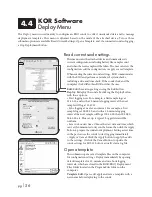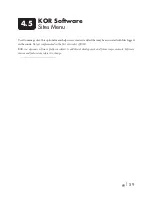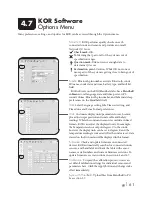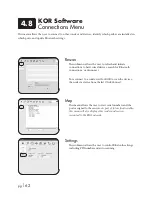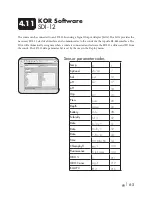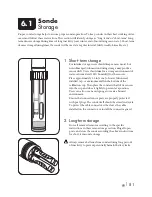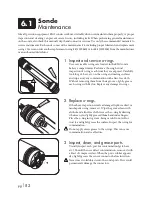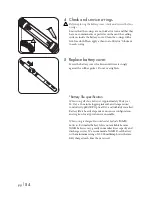
pg
|
69
ODO % sat or mg/L – 2-point (or zero point)
Normally it is not necessary to perform a 2-point calibration for the DO sensor, and the procedure is not
recommended unless (a) you are certain that the sensor does not meet your accuracy requirements at low
DO levels and (b) you are operating under conditions where you are certain to be able to generate a medium
which is truly oxygen-free.
For ODO % sat, calibrate your sonde at zero oxygen and in water-saturated air or air-saturated water. For
ODO mg/L, calibrate your sonde at zero oxygen and a known concentration of oxygen within ±10% of air-
saturation. The key to performing a 2-point calibration is to make certain that your zero-oxygen medium is
truly oxygen-free:
- If you use nitrogen gas for the zero-point calibration, make certain that the vessel you use has a
small exit port to prevent back diffusion of air and that you have completely purged the vessel before
confirming the calibration.
- If you use sodium sulfite solution for the zero-point calibration, prepare the solution at a
concentration of approximately 2 g/L at least two hours prior to use and keep it sealed in a bottle
which does not allow diffusion of oxygen through the sides of the container. Transfer the sodium
sulfite solution rapidly from its container to the calibration cup, fill the cup as full as possible with
solution to minimize head space, and seal the cup to the sonde to prevent diffusion of air into the
vessel.
Place the sonde with DO and temperature sensors in a zero-oxygen medium.
In the Calibrate menu, select ODO, then select either ODO % sat or ODO mg/L.
Click 2 Point for the Calibration Points. Enter Zero Point as the value of the first standard.
Click Start Calibration. Observe the readings under Current and Pending data points and when they
are Stable (or data shows no significant change for approximately 40 seconds), click Apply to accept this
calibration point.
- If you used sodium sulfite solution as your zero calibration medium, you must thoroughly remove
all traces of the reagent from the probes prior to proceeding to the second point. We recommend
that the second calibration point be in air-saturated water if you use sodium sulfite solution.
Next place the sensors in the medium containing a known oxygen pressure or concentration and wait at
least 10 minutes for temperature equilibration. Click Proceed in the pop-up window. Then enter either the
barometer reading in mm Hg (for ODO % sat) or the actual concentration of oxygen which was probably
determined from a Winkler titration (for ODO mg/L). Observe the readings under Current and Pending
data points and when they are Stable (or data shows no significant change for approximately 40 seconds),
click Apply to accept this calibration point.
Click Complete. View the Calibration Summary screen and QC score. Click Exit to return to the sensor
calibration menu, and then the back arrows to return to main Calibrate menu.
Carrying out DO mg/L calibrations at values outside the range of ±10 % of air saturation is likely to
compromise the accuracy specification of the EXO sensor.
Rinse the sonde and sensor(s) in tap or purified water and dry.
A


